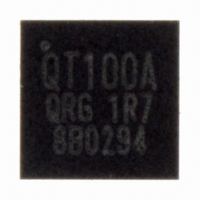QT100A-ISG Atmel, QT100A-ISG Datasheet - Page 3

QT100A-ISG
Manufacturer Part Number
QT100A-ISG
Description
IC SENS TOUCH/PROX 1CHAN 6-WSON
Manufacturer
Atmel
Series
QTouch™r
Type
Touch Sensing Controllerr
Datasheet
1.QT100A-ISG.pdf
(10 pages)
Specifications of QT100A-ISG
Input Type
Logic
Output Type
Logic
Current - Supply
600µA
Mounting Type
Surface Mount
Package / Case
6-WSON
For Use With
427-1128 - KIT EVAL FOR QT100
Lead Free Status / RoHS Status
Lead free / RoHS Compliant
Interface
-
Other names
427-1135-2
1 Overview
1.1 Introduction
The QT100A is a digital burst mode charge-transfer (QT)
sensor designed specifically for touch controls; it includes all
hardware and signal processing functions necessary to
provide stable sensing under a wide variety of changing
conditions. Only a single low cost, noncritical capacitor is
required for operation.
This device is designed to replace the QT100.
1.1.1 WSON package differences with QT100
A 6-pin WSON package version is available which uses the
same basic PCB footprint as the QT100’s SOT-23-6
package. The 6-WSON package has a reduced package
thickness.
In converting an existing design from the QT100 to the
QT100A, it should be noted that the 6-WSON package has a
bottom ‘center pad’ which must be either grounded
(connected to Vss) or isolated. This center pad is wide
enough that it can possibly touch the copper pads of the
QT100’s SOT-23-6 footprint, potentially creating a short
circuit between two or more pads. In order to prevent this the
solder mask layer of the PCB under the device should be
widened slightly, or, the copper PCB pads narrowed slightly
to avoid contact with the center pad. The pinout and pad
placement however are the same as for the QT100.
An application note is available to assist in this conversion
process.
A 10-pin MSOP package version is also available.
1.1.2 Electrical differences with QT100
The QT100A is behaviorally identical to the QT100, and no
change in the value of Cs is required to achieve the same
sensitivity as the QT100.
1.2 Basic Operation
Figure 1.1 shows a basic circuit using the device.
The QT100A employs bursts of charge-transfer cycles to
acquire its signal. Burst mode permits power consumption in
the microamp range, dramatically reduces RF emissions,
lowers susceptibility to EMI, and yet permits excellent
response time. Internally the signals are digitally processed
to reject impulse noise, using a 'consensus' filter which
requires four consecutive confirmations of a detection before
the output is activated.
The QT switches and charge measurement hardware
functions are all internal to the QT100A.
1.3 Electrode Drive
For optimum noise immunity, the electrode should only be
connected to SNSK.
In all cases the rule Cs>>Cx must be observed for proper
operation; a typical load capacitance (Cx) ranges from
2-20pF while Cs is usually from 2-50nF.
Increasing amounts of Cx destroy gain, therefore it is
important to limit the amount of stray capacitance on both
SNS terminals. This can be done, for example, by minimizing
trace lengths and widths and keeping these traces away from
power or ground traces or copper pours.
3
The traces and any components associated with SNS and
SNSK will become touch sensitive and should be treated with
caution to limit the touch area to the desired location.
A series resistor, Rs, should be placed in line with SNSK to
the electrode to suppress ESD and EMC effects.
1.4 Sensitivity
1.4.1 Introduction
The sensitivity on the QT100A is a function of things like the
value of Cs, electrode size and capacitance, electrode shape
and orientation, the composition and aspect of the object to
be sensed, the thickness and composition of any overlaying
panel material, and the degree of ground coupling of both
sensor and object.
1.4.2 Increasing Sensitivity
In some cases it may be desirable to increase sensitivity; for
example, when using the sensor with very thick panels
having a low dielectric constant. Sensitivity can often be
increased by using a larger electrode or reducing panel
thickness. Increasing electrode size can have diminishing
returns, as high values of Cx will reduce sensor gain.
The value of Cs also has a dramatic effect on sensitivity, and
this can be increased in value with the trade-off of slower
response time and more power. Increasing the electrode's
surface area will not substantially increase touch sensitivity if
its diameter is already much larger in surface area than the
object being detected. Panel material can also be changed to
one having a higher dielectric constant, which will better help
to propagate the field.
Ground planes around and under the electrode and its SNSK
trace will cause high Cx loading and destroy gain. The
possible signal-to-noise ratio benefits of ground area are
more than negated by the decreased gain from the circuit,
and so ground areas around electrodes are discouraged.
Metal areas near the electrode will reduce the field strength
and increase Cx loading and should be avoided, if possible.
Keep ground away from the electrodes and traces.
1.4.3 Decreasing Sensitivity
In some cases the QT100A may be too sensitive. In this case
gain can be easily lowered by decreasing Cs.
2 ~ 5V
Figure 1.1 Basic Circuit Configuration
*Cb
*Note: Bypass capacitor Cb should be tightly wired
between Vdd and Vss
OUT
VDD
VSS
QT100A, 6-WSON Pkg.
SNSK
SYNC
SNS
C opyright © 2008 QRG Ltd.
3
4
QT100A_1R7.01_0308
Cs
Rs
ELECTRODE
SENSE
Cx












